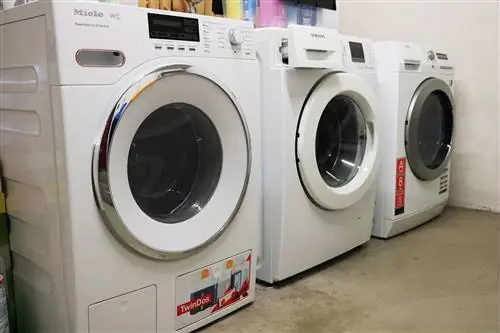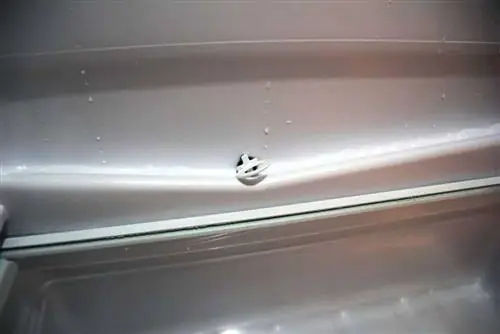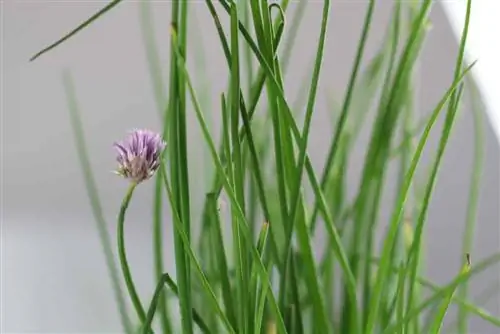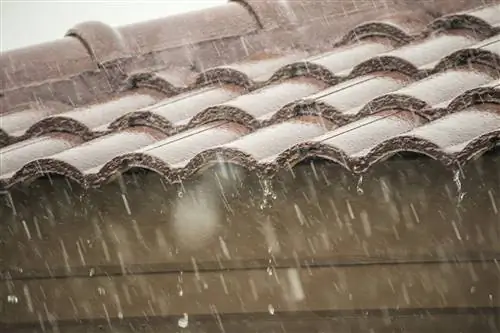- Author admin [email protected].
- Public 2023-12-17 03:39.
- Last modified 2025-01-24 12:45.
For anyone who owns their own house and garden, rainwater drainage is an unavoidable issue. The amount of precipitation must always flow away in a controlled and trouble-free manner so that flooding does not occur. Municipal sewers are an option, but this often costs a lot of money. Alternatively, you can infiltrate in your own garden. Read here about the different infiltration systems available.
The importance of water quality
Not all rainwater is allowed to seep into the garden without restriction. This is only permitted if the amount of pollutants it contains is not too high. Therefore, before setting up an infiltration facility, the contamination of the rainwater must be determined. It's not about the actual pollution, but rather about the potential risk of pollution to which the water is exposed. The following categories apply:
- safely contaminated
- tolerable burden
- untolerably burdened
Harmlessly contaminated water
Rainwater is considered uncontaminated if it comes from non-metallic roof surfaces and terrace areas in residential areas and comparable commercial areas. Harmlessly contaminated water is allowed to seep through a vegetated soil layer without further cleaning measures. But be careful: within certain water protection zones, no rainwater may seep away at all. Even safe water is not exempt from this ban. Therefore, find out in good time whether your garden is in such an area.
Tip:
You can usually get information about whether your garden is in a water protection area from the waterworks. The Office for Environmental Protection is also a suitable contact.
Tolerably polluted water
Water that is only exposed to a slight risk of pollution is still considered tolerable. This is usually the case with private property if it comes from the following areas:
- Walves
- Courtyards
- Garage entrances where vehicle washing is prohibited
- metallic roof surfaces
Tolerably polluted rainwater is allowed to seep away if it is first subjected to appropriate pretreatment. Infiltration is also possible if the contaminated water goes through cleaning processes in the infiltration system. Infiltration through a vegetated topsoil layer usually meets these requirements.
Untolerable polluted water

If rainwater comes from areas that are likely to be heavily polluted, it must under no circumstances seep into the garden. It must be collected separately and then sent via the sewage system to a sewage treatment plant. Fortunately, such a strong risk of pollution on residential properties is rare.
Note:
Rainwater must not be allowed to seep away on properties that have contaminated sites and soil contamination. Water seepage could cause pollutants in the soil to reach the groundwater.
Percolation ability of soil
The composition of the subsoil determines how well water can seep away. If the proportion of gravel and sand is high, the garden is well suited for infiltration. A clayey soil, on the other hand, is not sufficiently permeable to water. Since not every garden is the same, the water permeability should be checked. You can be on the safe side with a geological survey by a soil expert. The ability of the soil to seep away largely determines the suitable infiltration system.
Seepage in new buildings
In some federal states, infiltration is mandatory for new buildings. There is no freedom of choice here, it's just a matter of choosing the appropriate type of infiltration. Therefore, before starting construction, find out about the current legal status in your federal state.
Seepage in old buildings
In existing buildings, a rain infiltration system can also be retrofitted. There can be several occasions and reasons for this:
- upcoming changes to the sewer lines
- planned redesign of the garden, possibly pond installation
- Saving disposal fees for rainwater
- Environmental aspects
What infiltration systems are there?
If you want to let rainwater seep into the garden, you have various options to choose from:
- Area seepage
- trough seepage
- Shaft seepage
- Infiltration of drains
- trough seepage
Area seepage

With surface infiltration, the water seeps directly onto the permeable surface on which the rain falls. In addition, water from adjacent areas can be included if their insurance capacity is not sufficient.
- for little-used yards, terraces and garden paths
- technical effort is low
- good cleaning effect, provided the area is overgrown
- Space requirements are usually high
- especially if the soil is poorly drained
trough seepage
Rainwater infiltration is also possible via shallow depressions in the ground, so-called infiltration troughs. The hollows are specifically created in the garden for this purpose. The water to seep away is first introduced into it, where it gradually seeps through the overgrown bottom of the hollow into the ground. This is ideal during heavy downpours when the water cannot seep away so quickly.
- suitable for roof surfaces and terraces
- also for paths and courtyard areas
- good cleaning effect
- The hollow is about 30 cm deep
- is about 10 to 20 percent of the total area
- can be visually integrated into the garden
- variable planting possible
- Elaborate implementation for slope gardens
Tip:
By installing cascades, this type of rainwater infiltration can also work well in gardens with sloping surfaces.
Shaft seepage
Shaft seepage is another way to seep away rainwater. The water is led directly into the shaft, where it can seep away over the walls and bottom of the shaft. The polluted water is not cleaned, so that this type of seepage is now only approved in exceptional cases and only for uncontaminated water.
- low space requirement
- only a few square meters
- reaches more than 1 m deep
- ideal if only the deeper layer is permeable
- Areas above can be used as desired
- Rainwater is piped underground
- underground water reservoir
- Seepage through walls and floor
- upstream sludge trap
This infiltration system is difficult to maintain. If the fines cause a blockage, the removal is expensive.
Infiltration of drains
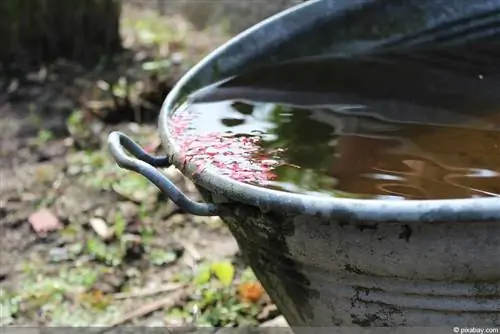
Infiltration ditches that are filled with gravel or coarse gravel are called trenches. The water is discharged directly into the ditch. The rainwater is temporarily stored in the underground part of the trench until it can completely seep away. This method lacks the cleaning effect of overgrown topsoil.
- low space requirement
- requires about 10-20% of the connected area
- suitable for roof surfaces
- also for paths and courtyard areas
- can be built in depth
- poorly permeable layers can be overcome in this way
- Length, width and depth depend on each other
- Areas above the trench can be used as desired
- Cached storage in the trench
- Seepage through the floor and walls of the trench
Digging the trench is labor-intensive and therefore takes a lot of time. Fine particles in the water can also lead to blockages. Unfortunately, the trench does not provide any opportunity for preventative maintenance.
Tip:
If the area above the trench is to be planted, only shallow-rooted plants should be chosen. Otherwise there is a risk of root penetration.
trough seepage
The trough infiltration is a combination of trough infiltration and trench infiltration. The trough is located above the trench filled with gravel. The rainwater first flows into the hollow and then seeps into the trench. It passes through a layer of overgrown topsoil and is thus cleaned.
- requires about 5-15% of the connected area
- Trough and trench serve as temporary storage
- Rainwater is piped in above ground
- good cleaning effect
- can be visually integrated into the garden
Approval and funding
An inspection by the responsible authority is required for rainwater seepage into the garden. The Office for Environmental Protection is usually the right point of contact for this. Relevant forms are also available there. Occasionally, states and municipalities promote the establishment of an infiltration system. It's worth making an inquiry about this.
Planning and implementation
Surface infiltration and trough infiltration are among the simpler infiltration methods. Here, as a garden owner, you can carry out the planning and implementation on your own. However, it must be ensured that the ground conditions are suitable for this. Otherwise, overflowing the system can cause damage, which can also affect the neighboring garden. Other infiltration systems are better served by professionals. At least the planning and calculation should be left to them.
Instructions for a seepage trough
An infiltration trough can be created relatively easily by garden owners themselves. The construction is explained step by step below.
- First calculate the size of the hollow and stake out the dimensions.
- Remove any vegetation or surface paving that may be present.
- Remove the topsoil, about 70 to 80 cm deep. First store it on the side next to it.
- Form a hollow out of the ditch with harmonious transitions to the rest of the garden. Use the excavated topsoil for this. The deepest part of the depression should lead to an area that can be flooded from time to time.
- Sow lawn seeds.
- Establish the supply line to the trough as soon as the lawn seed has sprouted.
Tip:
If your garden is very clayey, the hollow should be dug 15-20 cm deeper so that it can store more water. When forming the hollow, plenty of sand should also be added, which will increase the soil permeability.


